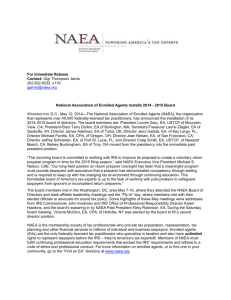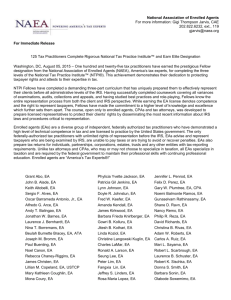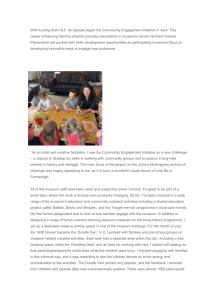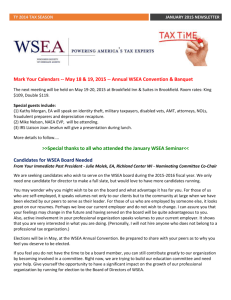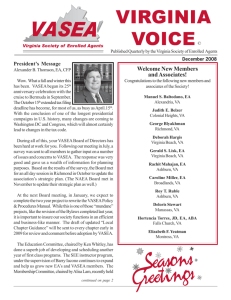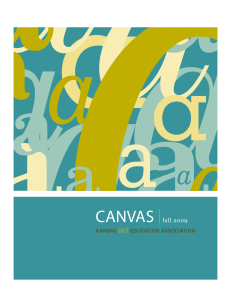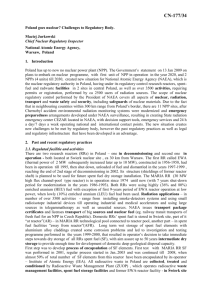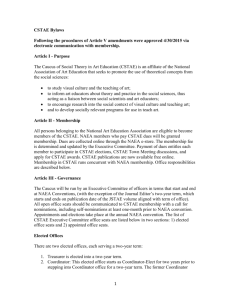Art Secondary BAE - EWU Access Home
advertisement
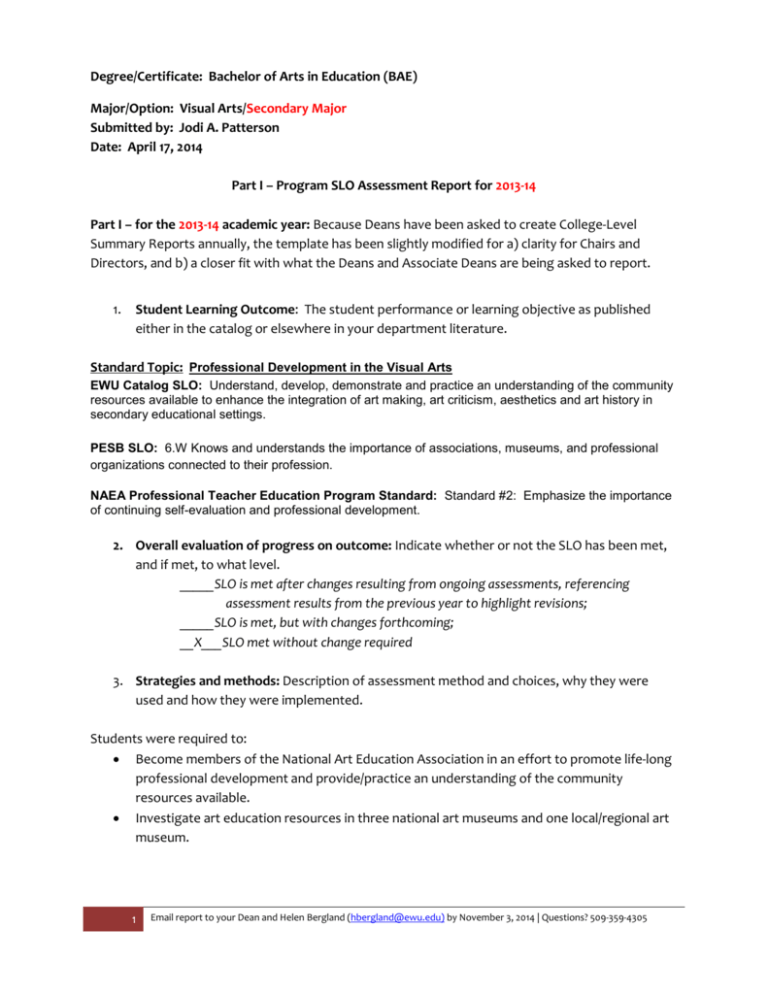
Degree/Certificate: Bachelor of Arts in Education (BAE) Major/Option: Visual Arts/Secondary Major Submitted by: Jodi A. Patterson Date: April 17, 2014 Part I – Program SLO Assessment Report for 2013-14 Part I – for the 2013-14 academic year: Because Deans have been asked to create College-Level Summary Reports annually, the template has been slightly modified for a) clarity for Chairs and Directors, and b) a closer fit with what the Deans and Associate Deans are being asked to report. 1. Student Learning Outcome: The student performance or learning objective as published either in the catalog or elsewhere in your department literature. Standard Topic: Professional Development in the Visual Arts EWU Catalog SLO: Understand, develop, demonstrate and practice an understanding of the community resources available to enhance the integration of art making, art criticism, aesthetics and art history in secondary educational settings. PESB SLO: 6.W Knows and understands the importance of associations, museums, and professional organizations connected to their profession. NAEA Professional Teacher Education Program Standard: Standard #2: Emphasize the importance of continuing self-evaluation and professional development. 2. Overall evaluation of progress on outcome: Indicate whether or not the SLO has been met, and if met, to what level. _____SLO is met after changes resulting from ongoing assessments, referencing assessment results from the previous year to highlight revisions; _____SLO is met, but with changes forthcoming; __X___SLO met without change required 3. Strategies and methods: Description of assessment method and choices, why they were used and how they were implemented. Students were required to: Become members of the National Art Education Association in an effort to promote life-long professional development and provide/practice an understanding of the community resources available. Investigate art education resources in three national art museums and one local/regional art museum. 1 Email report to your Dean and Helen Bergland (hbergland@ewu.edu) by November 3, 2014 | Questions? 509-359-4305 4. Observations gathered from data: Include findings and analyses based on the strategies and methods identified in item #3. a. Findings: Successfully acquired NAEA Membership (W, 2014) 2 out of 3 students Successfully linked to 3 national/1 local art museum Successfully linked museums to art education resources (W, 2014) 2 out of 3 students (W, 2014) 2 out of 3 students b. Analysis of findings: One student failed to acquire NAEA membership. Student blamed it on the cost, which is $35.00. Since there was no textbook assigned, I did not feel the cost was prohibitive. The benefits of membership include: Community. The NAEA website describes membership as, “Connect to Your Professional Community! Change is inevitable. In this increasingly visual age, it is important to be connected to developments in visual arts education as they are happening. As an NAEA member, you are connected the latest resources developed to enrich your career and the education of your students. You are a vital part of the only national professional organization established exclusively for visual arts educators, and you have the opportunity to share your experiences and learn from your colleagues. Connect to your professional community as an NAEA member and gain exclusive benefits that you can find nowhere else.” Development. Bi-monthly journal “Art Education; bi-monthly newspaper “NAEA NEWS; a twice-a-year research publication titled “Translations; and four sets of single topic articles that focus on timely issues in art education titled “NAEA Advisory.” Discounts. Price discounts are offered to members for national and state conventions. Access. Members can access NAEA online and member directory. All students were able to locate and link their digital portfolios to 3 national/1 local or regional art museum. One student failed to link specifically to the art education resources of the entities. Students selected the following resources: Student #1 Aspen Art Museum (W, 2014) Whitney Museum of American Art Hirshorn Museum of Art Student #2 National Gallery of Art (W, 2014) Smithsonian American Art Museum National Museum of Women in the Arts Student #3 The Museum of Modern Art (W, 2014) The Tate Museum The Whitney Museum of American Art 2 Northwest Museum of Art and Culture Northwest Museum of Art and Culture, Seattle Art Museum Email report to your Dean and Helen Bergland (hbergland@ewu.edu) by November 3, 2014 | Questions? 509-359-4305 All students were able to locate and link to museums One student failed to link to art education resources One student submitted two national museums and one museum based in London (The Tate) 5. What program changes will be made based on the assessment results? a) Describe plans to improve student learning based on assessment findings (e.g., course content, course sequencing, curriculum revision, learning environment or student advising). (Course Content Changes). I need to show clearer examples of opportunities art museums offer to educators, so all students will be able to recognize and utilize the wealth of resources, community and development offered online. (Course Content Changes). I also need to bring in NAEA membership packets to entice students to enthusiastically join the NAEA. Such a packet will include samples of NAEA publications and class time spent sharing online resources. Student Chapter of NAEA: Eastern Washington University needs to strive to form an official NAEA Student Chapter group. b) Provide a broad timeline of how and when identified changes will be addressed in the upcoming year. Clearer expectations will be presented the next time I teach the Art in the Secondary School Sign ups for NAEA Student Chapters are due before October 1st and February 1st – it may take a few years to gather enough students to form a Chapter. 6. Description of revisions to the assessment process the results suggest are needed and an evaluation of the assessment plan/process itself. This is a new assessment for the art education program, and the process/plan seems sufficient. 3 Email report to your Dean and Helen Bergland (hbergland@ewu.edu) by November 3, 2014 | Questions? 509-359-4305 NEW: PART II – CLOSING THE LOOP FOLLOW-UP FROM THE 2012-13 PROGRAM ASSESSMENT REPORT In response to the university’s accrediting body, the Northwest Commission on Colleges and Universities, this section has been added. This should be viewed as a follow up to the previous year’s findings. In other words, begin with findings from 2012-13, and then describe actions taken during 2013-14 to improve student learning along, provide a brief summary of findings, and describe possible next steps. Working definition for closing the loop: Using assessment results to improve student learning as well as pedagogical practices. This is an essential step in the continuous cycle of assessing student learning. It is the collaborative process through which programs use evidence of student learning to gauge the efficacy of collective educational practices, and to identify and implement strategies for improving student learning.” Adapted 8.21.13 from http://www.hamline.edu/learningoutcomes/closing-loop.html. 1. Student Learning Outcome(s) assessed for 2012-13 N/A – the Art Education program at EWU has been without a full-time faculty member for several years. There is no data to compute/compare. 2. Strategies implemented during 2013-14 to improve student learning, based on findings of the 2012-13 assessment activities. N/A – the Art Education program at EWU has been without a full-time faculty member for several years. There is no data to compute/compare. 3. Summary of results (may include comparative data or narrative; description of changes made to curriculum, pedagogy, mode of delivery, etc.): Describe the effect of the changes towards improving student learning and/or the learning environment. A full-time art education faculty member was hired in August of 2014. 4. What further changes to curriculum, pedagogy, mode of delivery, etc. are projected based on closing-the-loop data, findings and analysis? N/A. 4 Email report to your Dean and Helen Bergland (hbergland@ewu.edu) by November 3, 2014 | Questions? 509-359-4305
